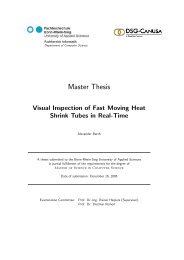Master Thesis - Hochschule Bonn-Rhein-Sieg
Master Thesis - Hochschule Bonn-Rhein-Sieg
Master Thesis - Hochschule Bonn-Rhein-Sieg
Create successful ePaper yourself
Turn your PDF publications into a flip-book with our unique Google optimized e-Paper software.
5. Algorithms <strong>Master</strong> <strong>Thesis</strong> Björn Ostermann page 64 of 126<br />
a) b) c)<br />
Figure 40: Reflection data, collected in a sample office environment<br />
a) unmodified, b) scaled greyscale values, c) histogram analysis<br />
5.1.2 Converting distance to colour<br />
As already mentioned, the range data is to be depicted using colours. In the depiction of heat images<br />
and stress images, it is common to use a colour-bar ranging from red to blue. This colour-bar, depicted<br />
in Figure 41, arises from the use of the RGB Colour space.<br />
0 m 7.5 m<br />
Figure 41: Converting 0 to 7.5m into colour<br />
It assigns the given range values to colour values from red over green to blue. For the maximum<br />
distance of the used camera of 7.5 meters, the distribution would be as depicted in Figure 41. For<br />
lower ranges the colour-bar can be adjusted, similar to the stretching algorithm explained in chapter<br />
5.1.2. The actual range has to be adjusted in the source code, no interface to the GUI was installed (see<br />
chapter 7.2).<br />
The RGB Colour space consists of every colour a standard monitor can show by mixing red, green and<br />
blue. Figure 42 shows the two used sides of the cube and the chosen path that leads to the colour-bar.<br />
To make the differences in the used colour-bar as severe as possible, only the colours on the cube’s<br />
edges are used.














